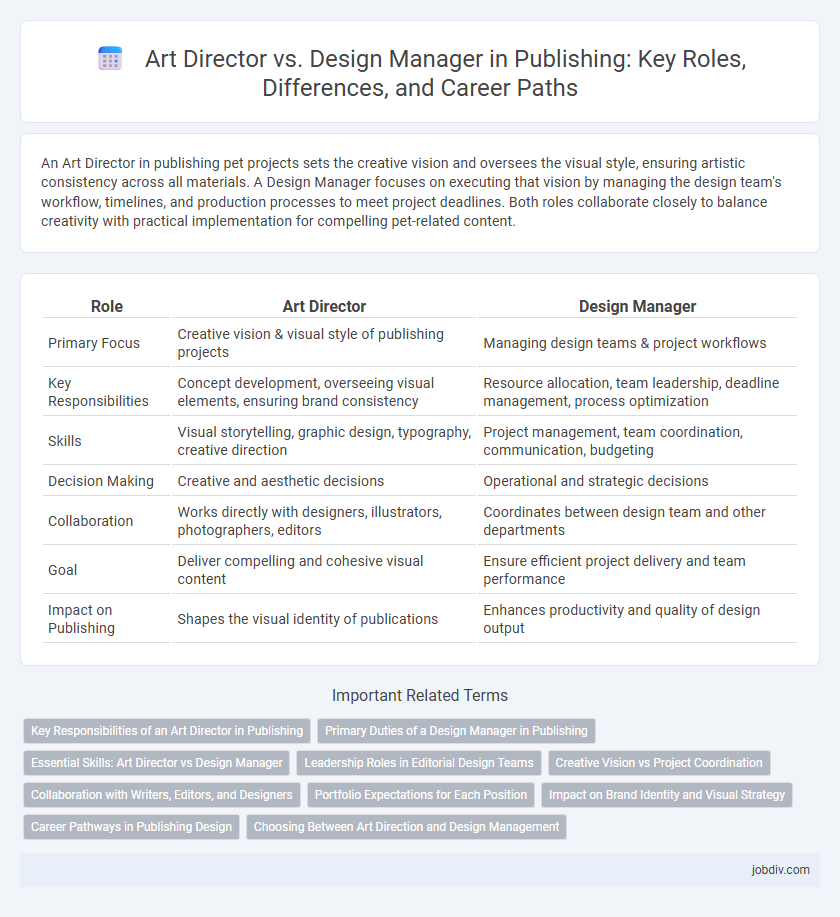An Art Director in publishing pet projects sets the creative vision and oversees the visual style, ensuring artistic consistency across all materials. A Design Manager focuses on executing that vision by managing the design team's workflow, timelines, and production processes to meet project deadlines. Both roles collaborate closely to balance creativity with practical implementation for compelling pet-related content.
Table of Comparison
| Role | Art Director | Design Manager |
|---|---|---|
| Primary Focus | Creative vision & visual style of publishing projects | Managing design teams & project workflows |
| Key Responsibilities | Concept development, overseeing visual elements, ensuring brand consistency | Resource allocation, team leadership, deadline management, process optimization |
| Skills | Visual storytelling, graphic design, typography, creative direction | Project management, team coordination, communication, budgeting |
| Decision Making | Creative and aesthetic decisions | Operational and strategic decisions |
| Collaboration | Works directly with designers, illustrators, photographers, editors | Coordinates between design team and other departments |
| Goal | Deliver compelling and cohesive visual content | Ensure efficient project delivery and team performance |
| Impact on Publishing | Shapes the visual identity of publications | Enhances productivity and quality of design output |
Key Responsibilities of an Art Director in Publishing
An Art Director in publishing oversees the visual style and imagery of magazines, books, or digital content, ensuring alignment with the publication's brand identity and editorial vision. They collaborate closely with designers, photographers, and editors to craft compelling layouts that enhance reader engagement and maintain aesthetic consistency across all materials. Their key responsibilities include directing photo shoots, approving design concepts, and managing creative teams to deliver high-quality visual content within deadlines.
Primary Duties of a Design Manager in Publishing
Design Managers in publishing oversee the entire creative process, ensuring visual content aligns with editorial goals and brand identity. They coordinate teams of designers, illustrators, and layout artists to produce high-quality layouts, book covers, and promotional materials on deadline. Their primary duties include project management, resource allocation, maintaining design standards, and liaising between editorial, marketing, and production departments.
Essential Skills: Art Director vs Design Manager
Art Directors excel in visual storytelling, creativity, and conceptualizing brand aesthetics, ensuring cohesive and impactful design across media. Design Managers specialize in project management, team leadership, and workflow optimization, coordinating multiple design projects and aligning creative output with business goals. Both roles require strong communication and collaboration skills, but Art Directors prioritize artistic vision while Design Managers emphasize operational efficiency.
Leadership Roles in Editorial Design Teams
Art Directors in editorial design teams focus on conceptualizing and overseeing the visual style, guiding creative direction, and ensuring cohesive storytelling through imagery. Design Managers prioritize workflow optimization, resource allocation, and cross-department collaboration to maintain efficient production schedules and project delivery. Both roles require leadership skills, but Art Directors drive creative vision while Design Managers handle operational execution.
Creative Vision vs Project Coordination
Art Directors in publishing drive the creative vision by shaping the visual style and ensuring artistic consistency across projects, emphasizing innovation and storytelling through design. Design Managers focus on project coordination, managing timelines, resources, and team collaboration to deliver high-quality designs efficiently. The Art Director prioritizes aesthetic impact, while the Design Manager ensures practical execution and workflow optimization within publishing teams.
Collaboration with Writers, Editors, and Designers
Art Directors coordinate closely with writers and designers to maintain visual storytelling that aligns with editorial tone, ensuring cohesive narrative flow across publications. Design Managers oversee the integration of creative assets and workflow processes, facilitating collaboration between editors and design teams to optimize project timelines and resource allocation. Both roles require effective communication skills to balance artistic vision with editorial objectives, enhancing the overall quality and consistency of the published content.
Portfolio Expectations for Each Position
Art Directors are expected to showcase a portfolio with a strong emphasis on visual storytelling, creativity, and innovative design concepts, highlighting their ability to lead and inspire artistic teams. Design Managers must present a portfolio demonstrating strategic project oversight, cross-functional collaboration, and successful execution of design projects that meet business goals. Portfolios for Art Directors emphasize artistic vision and originality, while Design Managers focus on problem-solving, workflow efficiency, and leadership in design processes.
Impact on Brand Identity and Visual Strategy
An Art Director shapes the brand identity by overseeing the creative vision and ensuring visual consistency across all publishing materials, directly influencing audience perception. A Design Manager implements this vision through managing design teams and workflows, optimizing productivity and quality control to align with strategic goals. Both roles collaboratively fortify brand identity, with the Art Director driving creative direction and the Design Manager ensuring effective execution within publishing projects.
Career Pathways in Publishing Design
Art directors in publishing typically focus on the creative vision and visual style of a project, leading teams to develop compelling layouts and graphics that enhance storytelling. Design managers oversee the production process, coordinating between creative teams and stakeholders to ensure timely delivery and brand consistency across multiple projects. Career progression often moves from hands-on design roles to leadership positions, with art directors advancing by honing creative expertise and design managers growing in project management and operational skills.
Choosing Between Art Direction and Design Management
Choosing between Art Direction and Design Management depends on whether you prioritize creative vision or project coordination. Art Directors focus on shaping the visual style and ensuring aesthetic consistency across publishing projects, while Design Managers oversee team workflows, deadlines, and resource allocation to maintain efficiency. Understanding the specific needs of your publishing project will guide whether a visionary leader or an operational manager is best suited for success.
Art Director vs Design Manager Infographic

 jobdiv.com
jobdiv.com